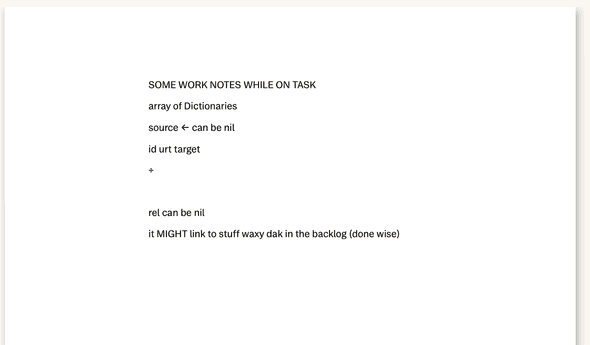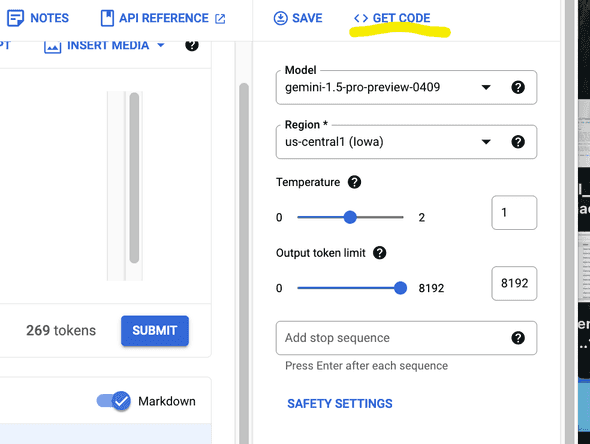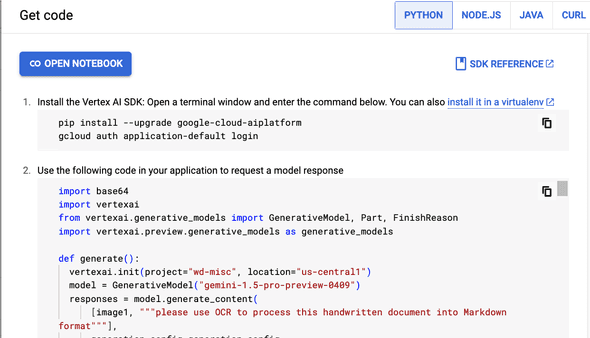Remarkable Handwriting with Vertex AI
April 19, 2024
Some Background: The Remarkable tablet
The Remarkable is an e-ink powered device that leans into writing as an experience. I often refer to it as the “infinity notebook”: in the UI you create notebooks which have pages, which you write on. Instead of a stack of notebooks I have my Remarkable.
Important to my purchase was the ability to get information out of the Remarkable. The Remarkable app, on desktops and iOS, lets you export Remarkable notebooks or individual pages to PDF, PNG, and SVG. In fact, that later one enables easy migration of handwritten drawings to OmniGraffle.
So far, for the most part, the features of the Remarkable supplement that focus. You can - and I do - enter text into the Remarkable via an onscreen or (proprietary) keyboard, and it can do handwriting recognition and conversion to text.
For my handwriting the conversion to text is OK, but not great. As such I rarely use it.
An example:
Remarkable’s Handwriting recognition output:
Not great.
Using GenAI for better handwriting recognition
The other day I was exploring Vertex AI on Google Cloud
Huh, I can upload media. I tried it with my sample page
If I adjust the temperature - which in Google-speak means creativity - I can (sometimes) get the AI to extrapolate from the information given. Most of the time I don’t want this, but it is a knob I could tweak.
Next Step
Then I asked myself: if Google can do this, can I write a shell script that runs this prompt with an arbitrary file, from my desktop?
After some flailing around I notice the Get Code button.
This reproduces your prompt in code, including what libraries you need to install
This also includes any attachments, saved in your code as base64 encoded data.
Doing it yourself, the final script
With some minor modifications I get the following script:
import sys
import base64
import vertexai
from vertexai.generative_models import GenerativeModel, Part
import vertexai.preview.generative_models as generative_models
PROJECT = "FILL ME IN HERE"
def multiturn_generate_content():
vertexai.init(project=PROJECT, location="us-central1")
model = GenerativeModel(
"gemini-1.5-pro-preview-0409",
)
chat = model.start_chat()
result = chat.send_message(
[document1_1, text1_1],
generation_config=generation_config,
safety_settings=safety_settings
)
print(result.candidates[0].content.parts[0].text)
file_path = sys.argv[1]
document = None
with open(file_path, "rb") as f:
document = f.read()
document1_1 = Part.from_data(
mime_type="application/pdf",
data=document)
text1_1 = """please use OCR to process this handwritten document into Markdown format."""
generation_config = {
"max_output_tokens": 8192,
"temperature": 1,
"top_p": 0.95,
}
safety_settings = {
generative_models.HarmCategory.HARM_CATEGORY_HATE_SPEECH: generative_models.HarmBlockThreshold.BLOCK_MEDIUM_AND_ABOVE,
generative_models.HarmCategory.HARM_CATEGORY_DANGEROUS_CONTENT: generative_models.HarmBlockThreshold.BLOCK_MEDIUM_AND_ABOVE,
generative_models.HarmCategory.HARM_CATEGORY_SEXUALLY_EXPLICIT: generative_models.HarmBlockThreshold.BLOCK_MEDIUM_AND_ABOVE,
generative_models.HarmCategory.HARM_CATEGORY_HARASSMENT: generative_models.HarmBlockThreshold.BLOCK_MEDIUM_AND_ABOVE,
}
multiturn_generate_content()
Which works!
Conclusion
The Google Vision API gives the ability to more directly interact with known quantities of documents, or if I provided my own data set. For example, the Vision API had templates for bills, bank statements, and forms. If I had more specific needs (translating a handwritten form 100 times a day, for example) I may look into those APIs. For now letting generative AI figure it out with a prompt and a given PDF file works great!





